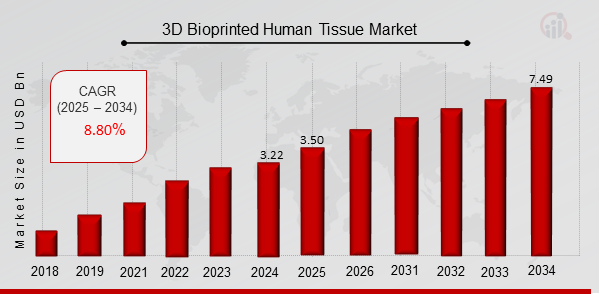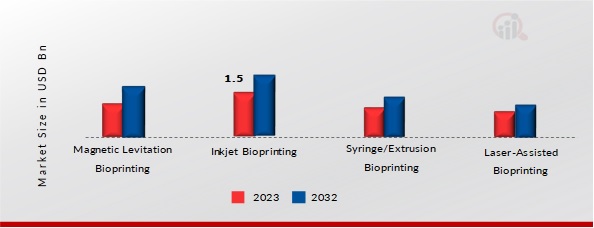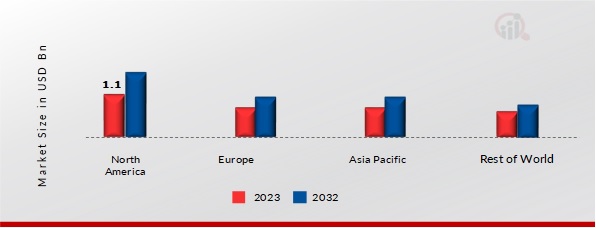Global 3D Bioprinted Human Tissue Market Overview
As per MRFR analysis, the 3D Bioprinted Human Tissue Market Size was estimated at 3.22 (USD Billion) in 2024. The 3D Bioprinted Human Tissue Market Industry is expected to grow from 3.50 (USD Billion) in 2025 to 7.49 (USD Billion) till 2034, at a CAGR (growth rate) is expected to be around 8.80% during the forecast period (2025 - 2034). The advancements in 3D bioprinters and biomaterials, expanding utilization of 3D bioprinting in pharmaceutical and cosmetology sectors, and escalating public and private investments in bioprinting research activities are expected to be significant market drivers for the 3D Bioprinted Human Tissue Market.

Source: Secondary Research, Primary Research, MRFR Database and Analyst Review
3D Bioprinted Human Tissue Market Trends
- Increasing use of 3D bioprinting in the pharmaceutical and cosmetic industries is driving the market growth
Market CAGR for 3D Bioprinted Human Tissue is driven by the increasing use of 3D bioprinting in the pharmaceutical and cosmetic industries. 3D bioprinting facilitates the creation of intricate 3D structures, which pose challenges when using traditional manufacturing methods. This advancement has opened avenues for producing complex drug compounds and formulations, along with cosmetic items like artificial skin, hair follicles, and other tissues. For example, Chinese startup Triastek secured $15 million in Series A funding in December 2020 to accelerate the development of its 3D-printed pharmaceuticals. The funding round, organized by fund management firm Dalton Venture, saw participation from Yunqi Partners and Shanghai Tofflon Science and Technology Chairman Zheng Xiaodong. Triastek intends to utilize the investment to establish a large-scale production line, conduct further research and development on its 3D-printed medications, and pursue registration applications in China and the U.S.
The market growth is expected to be driven by the increasing trend of product innovation and collaborations funded by both key market players and government agencies. In November 2022, as part of Northrop Grumman's 18th Commercial Resupply Services (NG-18) mission, an upgraded version of Redwire Space's BioFabrication Facility (BFF) was launched. This 3D bioprinter is capable of printing human tissue and is sponsored by the ISS National Laboratory. The project aims to pave the way for in-space bioprinting of tissues to assist patients on Earth, demonstrating how such product innovations contribute to market growth.
As a result, it is anticipated that throughout the projection period, demand for the 3D Bioprinted Human Tissue Market will increase due to the increasing use of 3D bioprinting in the pharmaceutical and cosmetic industries. Thus, driving the revenue of the 3D Bioprinted Human Tissue Market.
3D Bioprinted Human Tissue Market Segment Insights
3D Bioprinted Human Tissue Market Technology Insights
The 3D Bioprinted Human Tissue Market segmentation, based on Technology, includes Magnetic Levitation Bioprinting, Inkjet Bioprinting, Syringe/Extrusion Bioprinting, and Laser-Assisted Bioprinting. The inkjet bioprinting segment dominated the market, accounting for 58% of market revenue. The rapid and high-throughput deposition capabilities of inkjet bioprinting systems make them well-suited for industrial-scale production of 3D bioprinted tissues. This is crucial for addressing the increasing demand across various tissue engineering applications, such as drug discovery, regenerative medicine, and organ transplantation.
Figure 1: 3D Bioprinted Human Tissue Market, by Technology, 2023 & 2032 (USD Billion)

Source: Secondary Research, Primary Research, MRFR Database and Analyst Review
3D Bioprinted Human Tissue Market Application Insights
The 3D Bioprinted Human Tissue Market segmentation, based on the Application, includes Drug Testing and Development, Regenerative Medicine, Clinical Application, Food Testing, and Research. The Drug Testing and Development segment dominated the market, accounting for 58% of market revenue. Bioprinted organs play a crucial role in identifying drug side effects and aiding medicine developers in determining safe drug dosages for human administration. This technology facilitates rapid drug discovery, leading to shorter development times. According to Pharma Intelligence's data at the beginning of 2022, there were 11,351 drugs in the preclinical phase of research and development, indicating significant opportunities in the market. The US Food and Drug Administration is considering alternative methods for assessing drug safety and efficacy, presenting opportunities for market growth. Companies like Organovo, based in the US, have been pivotal in developing 3D bioprinters for creating liver and kidney tissue for drug discovery purposes.
3D Bioprinted Human Tissue Market Regional Insights
By region, the study provides market insights into North America, Europe, Asia-Pacific, and the Rest of the World. The anticipated expansion of the 3D Bioprinted Human Tissue market in North America can be attributed to several key factors. Several global 3D bioprinting solution providers are expanding their footprint in the North American market to bolster their market presence. In July 2022, Ohio State University in the United States partnered with Nexxt Spine, LLC, to launch a clinical trial. This trial aims to assess and compare radiographic and clinical outcomes in patients undergoing combined interbody/posterolateral lumbar fusion procedures. These procedures will utilize either the Nexxt Matrixx 3D-printed titanium cage or the Honour poly-ether-ether-ketone cage supplemented with pedicle screw instrumentation. Such partnerships and collaborations are anticipated to stimulate market growth.
Further, the major countries studied in the market report are the US, Canada, Germany, France, the UK, Italy, Spain, China, Japan, India, Australia, and South Korea.
Figure 2: 3D Bioprinted Human Tissue Market Share By Region 2023 (USD Billion)

Source: Secondary Research, Primary Research, MRFR Database and Analyst Review
Europe's 3D Bioprinted Human Tissue Market accounts for the second-largest market share as Organ shortage remains a significant global challenge, including within Europe. 3D bioprinting presents a promising avenue by offering an alternative to conventional organ transplantation. Spain boasted the highest organ transplant rate in 2023, reaching 112.4 transplants per million population. This marked an increase of approximately 13 compared to 2021, representing the largest rate surge across European nations. Following Spain, Belgium held the second-highest rate in 2023, with 81.8 transplants per million. In 2021, Spain also led Europe with a kidney transplant rate of 63.2 per million population. Furthermore, Spain recorded around 23 liver transplants per million in 2021, ranking fourth in Europe, surpassed only by Croatia, Italy, and Belgium. Although fully functional 3D bio-printed organs for transplantation are still in the early development stages, advances in tissue engineering are laying the groundwork for their eventual production. Further, the German 3D Bioprinted Human Tissue Market held the largest market share, and the UK 3D Bioprinted Human Tissue Market was the fastest-growing market in the European region.
The Asia-Pacific 3D Bioprinted Human Tissue Market is expected to grow at the fastest CAGR from 2025 to 2034. As per the Indian Brand Equity Foundation, the healthcare sector emerges as one of India's fastest-growing industries, projected to expand threefold to INR 8.6 trillion (USD 133.44 billion) by 2023. In the recent budget, India allocated 1.2% of its GDP to public healthcare expenditure, with plans to increase it to 2.5% of GDP by 2025. Such healthcare trends are poised to substantially drive market growth within the country. Numerous Indian startups are gaining traction by introducing innovative bioprinting solutions. For example, Biop, founded by students from BITS Pilani and Goa, aims to revolutionize medical research by developing equipment and technology for 3D bioprinting. Their product allows for the creation of human tissues with a single click, utilizing sensors, actuators, and UV technology to regulate the bioprinting process. Collaborating with prestigious institutions like MIT and Harvard, the company is spearheading advancements in the field. The burgeoning startup ecosystem, coupled with the rising elderly population and incidence of cancer cases, are significant drivers expected to propel market growth in the foreseeable future. Moreover, China’s 3D Bioprinted Human Tissue Market held the largest market share, and the Indian 3D Bioprinted Human Tissue Market was the fastest-growing market in the Asia-Pacific region.
3D Bioprinted Human Tissue Market Key Market Players & Competitive Insights
Leading market players are investing heavily in research and development to expand their product lines, which will help the 3D Bioprinted Human Tissue market grow even more. Market participants are also undertaking a variety of strategic activities to expand their global footprint, with important market developments including new product launches, contractual agreements, mergers and acquisitions, higher investments, and collaboration with other organizations. To expand and survive in a more competitive and rising market climate, the 3D Bioprinted Human Tissue industry must offer cost-effective items.
Manufacturing locally to minimize operational costs is one of the key business tactics used by manufacturers in the global 3D Bioprinted Human Tissue industry to benefit clients and increase the market sector. In recent years, the 3D Bioprinted Human Tissue industry has offered some of the most significant advantages to the healthcare sector. Major players in the 3D Bioprinted Human Tissue Market, including 3D Bioprinting Solutions, Allevi, Cellink Global, Cyfuse Biomedical K.K., EnvisionTEC, Inc., Inventia Life Science PTY LTD, Organovo Holdings, Inc., Poietis, Regemat 3D S.L., Vivax Bio, LLC are attempting to increase market demand by investing in research and development operations.
In 2021, Allevi joined the 3D Systems family as part of the company's strategic expansion into advanced bioprinting and regenerative medicine. The mission is to simplify the process of designing and engineering 3D tissues. The 3D bioprinters and bioinks provided by Allevi are utilized by prominent researchers globally to tackle humanity's most challenging issues, including disease treatment, drug testing, organ shortage mitigation, and life-oriented construction. Allevi by 3D Systems develops tools for designing and engineering living structures. Its desktop 3D bioprinters are renowned for their versatility, power, and user-friendliness, making them the preferred choice in numerous labs worldwide. The community of users continually inspires the company, engaging in groundbreaking research on its platform.
Organovo Holdings, Inc. utilizes its 3D tissue technologies to create human models of inflammatory bowel disease (IBD), aiming to understand, invent, and develop effective drug therapies for ulcerative colitis and Crohn’s disease. The drugs discovered through this method are believed to have a higher likelihood of demonstrating benefits in clinical trials. Organovo's lead therapeutic molecule, FXR314, has shown promise in treating ulcerative colitis in the company's disease models and extensive preclinical testing. In initial clinical trials, FXR314 has shown potential as a best-in-class FXR agonist, administered orally with high potency, safety, and tolerability, potentially avoiding dose-limiting toxicity issues observed in other FXR-targeted compounds. FDA authorization has been obtained for a Phase 2 trial of FXR314 in ulcerative colitis. Organovo plans to explore FXR314 for treating other inflammatory bowel diseases, including Crohn’s disease, as well as liver diseases, such as non-alcoholic steatohepatitis (NASH) and Primary Biliary Cholangitis. The company anticipates that FXR314 will have a broadening range of therapeutic applications as knowledge and scientific understanding continue to advance.
Key companies in the 3D Bioprinted Human Tissue Market include
3D Bioprinted Human Tissue Industry Developments
November 2022: Avay Biosciences launched an indigenous 3D printer capable of printing human tissues. Mito Plus represents an enhanced iteration of the Bio 3D printer, incorporating feedback from the prototype.
June 2022: REGEMAT 3D partnered with Humabiologics to address the increasing demand and cater to a wider customer base in the European bioprinting and drug testing market within the life sciences sector, encompassing industry partners and academic institutions
3D Bioprinted Human Tissue Market Segmentation
3D Bioprinted Human Tissue Market Technology Outlook
- Magnetic Levitation Bioprinting
- Inkjet Bioprinting
- Syringe/Extrusion Bioprinting
- Laser-Assisted Bioprinting
3D Bioprinted Human Tissue Market Application Outlook
3D Bioprinted Human Tissue Market Regional Outlook
- North America
- Europe
- Germany
- France
- UK
- Italy
- Spain
- Rest of Europe
- Asia-Pacific
- China
- Japan
- India
- South Korea
- Australia
- Rest of Asia-Pacific
- Rest of the World
- Middle East
- Africa
- Latin America
| Report Attribute/Metric |
Details |
|
Market Size 2024
|
3.22 (USD Billion)
|
|
Market Size 2025
|
3.50 (USD Billion)
|
|
Market Size 2034
|
7.49 (USD Billion)
|
|
Compound Annual Growth Rate (CAGR)
|
8.80 % (2025 - 2034)
|
|
Report Coverage
|
Revenue Forecast, Competitive Landscape, Growth Factors, and Trends
|
|
Base Year
|
2024
|
|
Market Forecast Period
|
2025 - 2034
|
|
Historical Data
|
2020 - 2024
|
| Report Coverage |
Revenue Forecast, Market Competitive Landscape, Growth Factors, and Trends |
| Segments Covered |
Technology, Application, and Region |
| Geographies Covered |
North America, Europe, Asia Pacific, and the Rest of the World |
| Countries Covered |
The US, Canada, Germany, France, UK, Italy, Spain, China, Japan, India, Australia, South Korea |
| Key Companies Profiled |
3D Bioprinting Solutions, Allevi, Cellink Global, Cyfuse Biomedical K.K., EnvisionTEC, Inc., Inventia Life Science PTY LTD, Organovo Holdings, Inc., Poietis, Regemat 3D S.L., Vivax Bio, LLC |
| Key Market Opportunities |
· Rising demand for organ transplant |
| Key Market Dynamics |
· An increasingly aging population with chronic respiratory diseases |
Frequently Asked Questions (FAQ) :
The 3D Bioprinted Human Tissue Market size was valued at USD 2.7 Billion in 2023.
The 3D Bioprinted Human Tissue Market is projected to grow at a CAGR of 8.80% during the forecast period, 2025-2034.
North America had the largest share of the global market.
The key players in the market are 3D Bioprinting Solutions, Allevi, Cellink Global, Cyfuse Biomedical K.K., EnvisionTEC, Inc., Inventia Life Science PTY LTD, Organovo Holdings, Inc., Poietis, Regemat 3D S.L., Vivax Bio, LLC, and others.
The Inkjet Bioprinting segment dominated the market in 2023.
The Drug Testing and Development segment had the largest share of the global market.

















